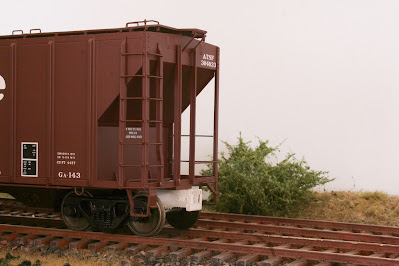After having test fitted one of the coupler boxes on a car it was time to figure out how the couplers should be installed in the boxes.
For starters, I inserted a shim at the top inside of the box. This would not only lower the coupler to the correct height but would also make the coupler shank clear the upper "lip" at the box opening, As a bonus the shim, which was made out of .75 mm styrene, also added to the thickness of the top part of the box. Which would be good for the screw threads to come. Here are two of the boxes and the styrene shims to be glued in place inside the boxes. The shims could be no longer than that, or they would foul one of the box mounting screws. In the picture below the boxes are upside down, so the shim would go at the "bottom" in the picture.
Next I drilled and tapped a hole in the box for the coupler mounting screw (the smaller hole in the picture below). I also drilled a matching hole in the coupler shank, and shortened the shank. The latter so that I would get sufficient coupler swing inside the box, although the mounting screw is offset towards one end of the shank.
And here the coupler is in place in the box (and still everything is upside down in the picture).
As can be seen the coupler is no longer in its pristine brass state. This since it has been "blackened" in vinegar. I searched the net for ways of blackening brass, and found acetic acid, better known as vinegar. Since vinegar is easy enough to obtain I decided to try it. It did the job, but it was not a fast process. I think the coupler sat in the vinegar for 10 days or a fortnight, but eventually it changed color.
Here the complete assembly has been test fitted on one of the cars.
And last, the compulsory comparison to the stock coupler.
Here is a short video showing that the coupler mechanism still works after the vinegar treatment.
Next is coupler box painting and weathering. Stay tuned.
























































